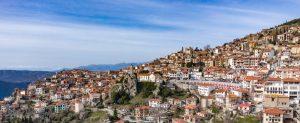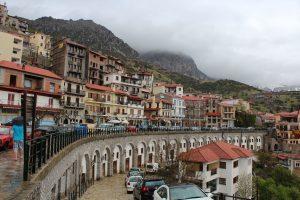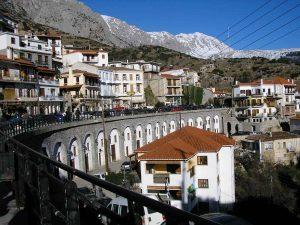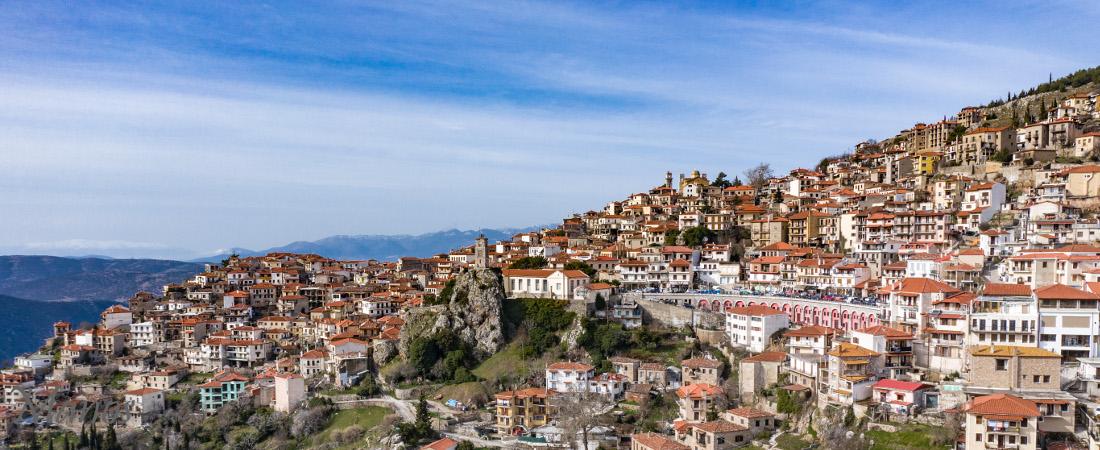Arachova Village
Arachova Village is a favorite destination for passionate ski lovers and celebrities. Or just first-time visitors who wish to relax in a dreamy mountainous setting with modern tourism facilities.
Its modern ski resort, its proximity to Athens City, and its breathtaking mountainous landscape are the strongest reasons to visit.
Apart from the Parnassus mountain activities, Arachova Village is also famous for its bustling nightlife, as it is the favorite Mt. Parnassus mountain resort of Athenians. It is located 35 km west of Levadeia town.
Associated figures of importance
It was here that Georgios Karaiskakis (1780-1827) defeated the Turkish army led by Moustafabei in November 1826.
The Byzantine Churches of the Arachova Village with their well-preserved frescoes are a must-visit.
The area of Arachova Village is full of ancient settlements, dating back to 1200 BC. Additionally, you can find scattered traces of antiquity from Parnassus mountain to Zemeno and below to the valley of Pleistou.
At Korykeio Andro, the oldest traces are aged back to the Neolithic period (3000 BC approximately). On the west side of Arachova Village was Anemoreia or Anemoleia, a Homeric town, such as Kyparissos, located in the east of Arachova Village.
Lykoreia, an ancient town high on Parnassus mountain, takes us back to the times of the Great Flooding. Then in Liakoura, the highest peak of the mountain (2457 m) stood still the ark of Defkaliona and Pyrra, who gave birth to Hellin, the first person of the Hellenic race.
But the name Parnassus itself, a pre-hellenic word, brings us to the depths of time, before 2000 BC.
History and occupation
The first traces of occupation in Arachova Village are found in the form of settlements on the hill “Koumoulas” of Parnassus mountain, where there are relics from the Middle (1,900 – 1,600 BC) and Late Hellenic period (1,600 – 1,100 BC), and at the “Kastrouli” of Zemenos (form Late Hellenic years).
The area of Arachova Village in antiquity (after the 10th century BC) was in Phocis and the habitation was thick, particularly in the Classic (500 – 300 BC) Hellenistic (300 – 100 BC), and Roman times (100 BC 400 BC), in two major cities in “Paliopyrgo” and “Nekrotafeio” and, in the form of small settlements, in wider areas of Parnassus mountain, “Pania” and “Elaiwna”.
In the area of “Pania” there is also an old Christian Settlement (4th, 7th century AD), characterized by the existence of three one-room temples.
The habituation of the area continued in the same settlement until the Middle years (l0os – llos AD) and then moved to the site of the current settlement.
The French historian Pouqueville says that Arachova Village in the 13th century was ruled by a noble of the family de Nolse.
Also, Kyriacos traveler from Ancona in 1435, who passed through Arachova Village, says that the city was highly populated.
Local cuisine
Furthermore, you can discover the traditional character of the Arachova Village by taking leisurely walks through its narrow cobblestone streets.
Enjoy hot and sweet food or soft and fruity drinks in cafés, or traditional kafeneia (coffee shops).
Additionally, while there, you should try out these local specialties:
- kontosoúvli big hunks of pork skewered and put on a rotisserie with onions
- tomatoes, peppers seasoned with salt and pepper, garlic and oregano
- kokorétsi the intestines of the lamb stuffed with offal
- sarmádes stuffed grape leaves
- traditional pies
- handmade trahanás pasta soup, which can be sweet or sour
- hilopites egg noodles are made in linguine-sized strips, cut into small pieces
The Village of Arachova is well-known for its textiles, woodwork, dry wines, and the local cheese called “formaela”. It also produces a sweet-smelling hard rind cheese with a relatively mild flavor that you should taste!
Sip the divine Parnassus local wine, the red “Mavroudi”. It achieved Protected Designation of Origin status in 2006. The “Black Aráhova vine” is a full-bodied prolific variety. It produces wines of a deep red hue with a high alcohol content as well as a distinct flavor.
To conclude, you can complete your meal with traditional “spoon-sweets”, or even better, try traditional Greek Yogurt with honey, a dessert served compliments of the house. Before you leave, pick up some hand-made beautifully colored woven carpets (flocati rugs) and textiles to take with you as a souvenir.
What Other People Say…
Recent Reviews
Submit your review | |
Honestly, I booked this last minute and had no big expectations, but it turned out to be a really good day. Delphi was super cool—even if you’re not a history nerd, the place has a crazy vibe, like it’s still alive somehow. The guide was chill, not boring, which I appreciated. Arachova was like a Greek mountain version of a ski town. We grabbed a pastry and wandered a bit. It’s a lot packed into one day, but didn’t feel stressful at all.
This tour is excellent if you're short on time but want to see something special outside of Athens. The bus was on time and very clean. Delphi is absolutely fascinating, especially if you like mythology and ancient ruins. I only wish we had 30 minutes more at the site. Arachova was nice for photos and coffee. All in all, good value and well organized.
We had an amazing day on this tour from Athens. The bus was comfy and left right on time. Our guide was really knowledgeable and made the history of Delphi so interesting without being boring. The ruins were incredible and the museum had some really cool pieces, especially the bronze statue. We stopped in Arachova after and it was like a little postcard town in the mountains—had a coffee there and just enjoyed the views. Highly recommend if you have limited time in Greece.




